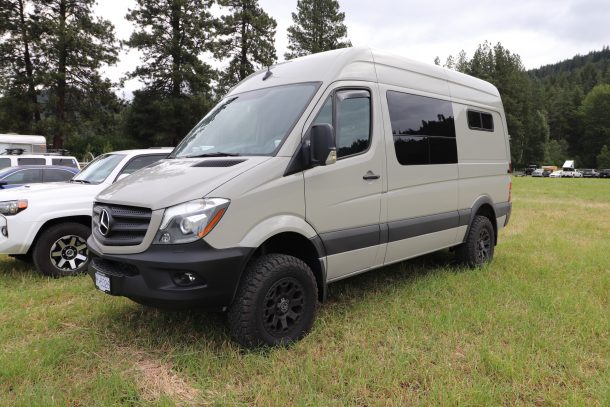Camper Van Deliveries Up 125 Percent in November
Camper vans, ubiquitous homes on wheels for digital nomads, were up 125 percent in total shipments in November, according to the RV Industry Association. This was part of total RV shipments that finished the month with 42,513 units, a 43.4 percent increase over the 29,644 units shipped in November of last year.
“RV manufacturers continue to post impressive shipment numbers as they work to meet the sustained demand for RVs,” said RVIA President Craig Kirby. “Our survey data shows this demand will continue in 2021, with 61 million Americans planning to take an RV trip in the next twelve months.”
Towable RVs, led by travel trailers, totaled 38,485 units for the month, an increase of 46.3 percent compared to last November’s aggregate of 26,297 units. Truck campers, units that slide into pickup beds or mount to flatbed platforms, registered 505 units, up 73.5 percent from 291 the past year.
Motorhomes finished the month with 4,028 units, up 20.3 percent compared to the November 2019 total of 3,347 units. This segment is comprised of Class A, Class B or van campers, and Class C motorized RVs.
Shipments stand at 390,030 units, up 3.0 percent for the year as the RV industry attempts to get a handle on consumer demand. The industry no doubt owes a debt of gratitude to Vice-President Mike Pence, the former governor of Indiana, where most of the RVs in the U.S. are manufactured. Pence quietly lobbied for and won support for the designation of the industry as essential workers, allowing manufacturers to continue largely unimpeded.
Wholesale RV shipments are forecasted to gain nearly 20 percent to 502,582 units in 2021 after totaling 423,628 units in 2020. This projection predicts total shipments ranging between 490,300 and 515,400 units with the most likely 2021 year-end total reaching 502,582, an 18.7 percent increase over 2020. Over the next two months, shipments are anticipated to finish within a range of 414,100 to 433,100 units with the most likely outcome being 423,638 units. That total would represent a 4.3 percent gain over the 406,700 units in 2019.
[Images: © 2020 J. Sakurai/TTAC, RVIA]
With a father who owned a dealership, I literally grew up in the business. After college, I worked for GM, Nissan and Mazda, writing articles for automotive enthusiast magazines as a side gig. I discovered you could make a living selling ad space at Four Wheeler magazine, before I moved on to selling TV for the National Hot Rod Association. After that, I started Roadhouse, a marketing, advertising and PR firm dedicated to the automotive, outdoor/apparel, and entertainment industries. Through the years, I continued writing, shooting, and editing. It keep things interesting.
More by Jason R. Sakurai
Latest Car Reviews
Read moreLatest Product Reviews
Read moreRecent Comments
- Rover Sig 2021 Jeep Grand Cherokee Limited, like my previous JGC's cheap to keep (essentially just oil, tires) until recent episode of clunking in front suspension at 50K miles led to $3000 of parts replaced over fives visits to two Jeep dealers which finally bought a quiet front end. Most expensive repair on any vehicle I've owned in the last 56 years.
- Bob Hey Tassos, have you seen it with top down. It's a permanent roll bar so if it flips no problem. It's the only car with one permanently there. So shoots down your issue. I had a 1998 for 10 years it was perfect, but yes slow. Hardly ever see any of them anymore.
- 3-On-The-Tree 2007 Toyota Sienna bedsides new plugs, flat tire on I-10 in van Horn Tx on the way to Fort Huachuca.2021 Tundra Crewmax no issues2021 Rav 4 no issues2010 Corolla I put in a alternator in Mar1985 Toyota Land Cruiser FJ60 280,000mi I put in a new radiator back in 08 before I deployed, did a valve job, new fuel and oil pump. Leaky rear main seal, transmission, transfer case. Rebuild carb twice, had a recall on the gas tank surprisingly in 2010 at 25 years later.2014 Ford F159 Ecoboost 3.5L by 80,000mi went through both turbos, driver side leaking, passenger side completely replaced. Rear min seal leak once at 50,000 second at 80,000. And last was a timing chain cover leak.2009 C6 Corvette LS3 Base, I put in a new radiator in 2021.
- ChristianWimmer 2018 Mercedes A250 AMG Line (W177) - no issues or unscheduled dealer visits. Regular maintenance at the dealer once a year costs between 400,- Euros (standard service) to 1200,- Euros (major service, new spark plugs, brake pads + TÜV). Had one recall where they had to fix an A/C hose which might become loose. Great car and fun to drive and very economical but also fast. Recently gave it an “Italian tune up” on the Autobahn.
- Bd2 Lexus is just a higher trim package Toyota. ^^






































Comments
Join the conversation
Most people that buy an RV, unless you are going to live in it, let it sit in their driveway or storage for 10/11 months out of the year, then wind up ditching them to the next schmuck who thinks they are going to "see the country" living the good easy frontier life that is portrayed in the advertising!
RV ownership is pricey and it's a luxury unless you do it full time. I don't have a camper right now but have been looking for a small travel trailer. I have borrowed and been camping with others a number of times with my kids and grew up with a 26' travel trailer. I find camping with the kids way less stressful then hotel stays, a lot of that has to do with more places for active kids to roam, in the end it dosen't save any money over vacationing in a hotel but the experience is far different.